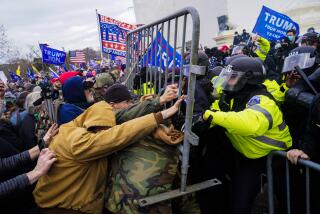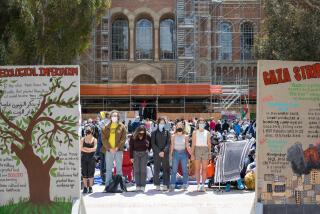One-sided view of a memorial
- Share via
If history is indeed written by the victors, then the American Battle Monuments Commission has found its stenographer in Nicolaus Mills. The commission, a small independent agency of the federal government’s executive branch, ignited a firestorm of controversy with the mediocre design and inept siting of the long-overdue National World War II Memorial, dedicated last spring on the Mall in Washington, D.C.
Mills, a professor of American studies at Sarah Lawrence College, makes two difficult claims in his book.
First, despite a lack of credentials in art or architecture, he asserts that the memorial’s design and siting are just fine. His aesthetic observations are jejune, but far more important is the second claim.
Mills avers that opposition to the project did not arise from principled differences of critical opinion but largely from the knee-jerk response of liberals, whose dissent in the face of government power sometimes seems merely obligatory. The quarrels, he writes, “reflect both our current distrust of government as well as the need we have had to come together as a nation since the Sept. 11 attacks.” How a quarrel that began long before Sept. 11 “reflects” post-Sept. 11 psychological needs is not explained.
Mills, who is no Ann Coulter, might be expected to know something about politics and culture.
As a member of the editorial board of the venerable leftist quarterly Dissent, he brings a certain understanding to the table.
But his analysis of the memorial controversy is poorly conceived. Supporters of the plan blasted opponents as a small band of troublemakers from outside official Washington who entangled a worthy project in a bureaucratic snarl. Mills accepts their view. What actually happened, as I’ve written before, is that a heroic group of ordinary American citizens caught the federal bureaucracy with its pants down and promptly blew the whistle in the press and, later, the courts.
One problem with the book concerns history, the other interpretation.
Forget (if you can) the inference of fascist oppression at play in the cheesy title, “Their Last Battle.” Heroic, aging World War II veterans are implied as united in a final struggle against an immoral enemy to get “their” memorial built. Yet many heroic, aging veterans also vigorously opposed the dismal project. Impugning the patriotism of adversaries, even by inference, is unworthy of the good professor.
Worse, the melodramatically titled book distorts history. Turn to the central event -- choosing a memorial site in Washington. The structure was originally planned for Constitution Gardens, one of several possible sites duly approved by the relevant government agencies. It ended up being built at the eastern end of the Lincoln Memorial’s grounds, which was on no approved list of options. The relocation was marked by surreptitious, even shady maneuvering -- a backroom power play.
But not in Mills’ book, whose footnotes reveal the problem. His factual account of the 1995 switcheroo was gleaned from official minutes of public meetings, while the interpretation of those facts comes solely from the author’s interviews with the two men who pulled it off. They are hardly disinterested parties.
The interviews were conducted years later, after controversy had erupted, damning new facts had emerged and construction of the memorial was underway. Among the new facts were a pair of previously unreleased reports, commissioned by the National Park Service in 1996, that definitively showed that the World War II Memorial was being sited on the grounds of the Lincoln Memorial -- a violation of federal law.
Mills airily dismisses this as a “textual argument.” He quotes an op-ed piece in the Washington Post supposedly proving that today’s eastern end of the Lincoln Memorial was not part of its original 1922 design. Then, he quotes another historian to the effect that the argument doesn’t matter anyway, because the Mall, like any historic site, must evolve: “Preservation doesn’t freeze dry something. It’s about managing change.”
I agree. And one thing that has changed dramatically over eight decades is the Lincoln Memorial and its grounds. Thanks to Marian Anderson in 1939 and the Rev. Martin Luther King Jr. in 1963, the area encompassing Lincoln’s shrine, the Reflecting Pool below it and the Rainbow Pool at the eastern end has evolved into the nation’s preeminent civil rights memorial. Public use over time has inflected its original meanings -- which was one finding of the park service’s suppressed reports! The World War II Memorial violates the federal Commemorative Works Act because it interferes with and encroaches upon an existing memorial.
Textual or not, the legal argument never had a chance to be made during the memorial’s grossly mismanaged public review process.
As American Battle Monuments Commissioner F. Haydn Williams was notoriously quoted as bragging at the time, “The site was approved before they [the public] knew what hit them. Then they came out of the woodwork.” I did not find Williams’ contemptuous -- and revealing -- comment in Mills’ book.
The author mostly avoids the issue of procedural corruption. For example, Mills blandly recounts objections to the memorial made by the federal Advisory Council on Historic Preservation; but he doesn’t say that the approval process required that the council’s report be submitted to the National Park Service before the final decision on a memorial site. In fact, it came five years after the site was chosen.
Mills also falls hook, line and sinker for the commission’s shrewd advertising campaign. To flatten the opposition, sentimental appeals were made to the so-called Greatest Generation, dying at the rate of 1,000 a day, who might never see their memorial finished. The nearby monuments to Washington and Lincoln were also falsely characterized as war memorials -- to the Revolution and the Civil War -- so that a 20th century war memorial might seem appropriate if sited between them.
Even if one were to believe the phony claim about the Washington and Lincoln war memorials -- a canard now carved in stone at the World War II Memorial’s ceremonial entrance -- it actually weakens the plea about “dying veterans.” The Lincoln Memorial was dedicated almost six decades after the Civil War ended, the Washington Monument a full century after the Revolutionary War was over. Veterans weren’t much in attendance at the festivities.
Mills writes in his preface that “the chance to be the biographer of the National World War II Memorial is a once-in-a-lifetime opportunity.” Think of his skewed tale of travesty on the Mall as the official, authorized biography. An actual history waits for another day.
More to Read
Sign up for our Book Club newsletter
Get the latest news, events and more from the Los Angeles Times Book Club, and help us get L.A. reading and talking.
You may occasionally receive promotional content from the Los Angeles Times.








